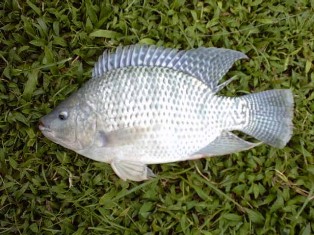Greg Lutz, Extension Professor, Louisiana State University AgCenter
Tilapia Production
Tilapia, the common name for a group of several cichlid species native to Africa and the Middle East, are grown in many parts of the world and in a variety of production systems ranging from small, fertilized ponds to industrial-scale, export-driven farm operations. During the past decade, tilapia became the second-most commonly consumed farmed fish on the planet, surpassed only by carps (FAO 2006). Tilapia are hardy, fast-growing fish that tolerate a range of environmental conditions. They are, however, tropical by nature, and this limits opportunities for their commercial culture in most of North America. Most tilapia products consumed in the United States are imported. As a result of lower production costs and longer growing seasons, overseas producers have distinct advantages in the marketplace. Frozen fillets are largely imported from China and to a lesser extent from other Asian countries. Most fresh fillets in U.S. markets are imported from Latin America, where Honduras, Ecuador, and Costa Rica have historically led the region in tilapia exports. The only significant tilapia market segment available to U.S. producers over the past two decades has been the live market. Large urban areas in the Northeast, upper Midwest, and Pacific Northwest are home to many Asian communities with a high demand for live fish. Similarly, California and the Southwest region have many Hispanic communities where live fish, especially live tilapia, are easily marketed. Due to the tropical nature of tilapia, most domestic production relies on seasonal pond culture (often with indoor overwintering of juveniles and/or broodstock) in southern and southwestern states or on the use of indoor recirculating aquaculture facilities. Both approaches have technical and economic constraints (Lutz 2000), but domestic tilapia production has typically ranged from 10 to 20 million pounds annually over the past two decades.
Tilapia Production in Recirculating Systems
Recirculating aquaculture requires significant energy consumption for moving, aerating, and filtering water. Heating costs are also high in certain locations. With the exception of green-water systems exposed to sunlight, recirculating production also requires 100% nutritionally complete diets. In recirculating systems, it is crucial to maintain biological filtration (and the naturally occurring bacteria that break down ammonia and nitrite) operating at optimum levels. Since tilapia can tolerate high levels of crowding, producers occasionally “push” the capacity of recirculating systems by adding pure oxygen to the water. While this practice can increase carrying capacity significantly, it typically requires additional effort to prevent the accumulation of carbon dioxide in the water and adds to the constant risk of operational failure due to mechanical problems or human error.
To utilize the capacity of recirculating systems more efficiently, various size groups are typically cultured at the same time. This practice also helps maintain more consistent sales and cash flow. As a result of natural variability in growth, tilapia require size grading at least once (and usually two or more times) during the production cycle. Some recirculating configurations lend themselves more easily to this practice than others.
In recent years, increasing costs of feed and energy have resulted in the failure of many recirculating tilapia facilities. Although technology continues to improve, with the promise for greater economic efficiency, high feed and energy costs will continue to severely constrain recirculating tilapia production.
Tilapia Production in Outdoor Ponds
Tilapia are also produced seasonally in outdoor ponds in a number of states where suitable temperatures occur, specifically from southern California to Florida and as far north as Arkansas. Once water temperatures reach approximately 70°F, fingerlings are stocked at approximately 4,000 to 6,000 per acre depending on the length of the growing season and market preference for size at harvest. For pond production to be marginally feasible, a growing season of 180 days or more is usually required. Most live markets prefer a minimum average weight of 525 g. The need to move an entire season’s production during a short time frame (before ponds become too cold for the fish to survive) severely limits marketing opportunities for pond producers in many areas. Engle (1997a,b) provided a broad review of economic and marketing considerations associated with commercial tilapia production throughout the Americas.
References
Engle, C.R. 1997a. Economics of tilapia aquaculture. Pages 229–243 in B.A. Costa-Pierce and J.E. Rakocy, eds. Tilapia Aquaculture in the Americas, Vol. 1. The World Aquaculture Society, Baton Rouge, Louisiana, USA.
Engle, C.R. 1997b. Marketing Tilapias. Pages 244–258 in B.A. Costa-Pierce and J.E. Rakocy, eds. Tilapia Aquaculture in the Americas, Vol. 1. The World Aquaculture Society, Baton Rouge, Louisiana, USA.
FAO. 2006. The State of the World Fisheries and Aquaculture 2006. Rome. (pdf)
Lutz, C.G. 2000. Production economics and potential competitive dynamics of commercial tilapia culture in the Americas. Pages 119–132 in B.A. Costa-Pierce and J.E. Rekocy, eds. Tilapia Aquaculture in the Americas, Vol. 2. The World Aquaculture Society, Baton Rouge, Louisiana, United States.
Tilapia Publications
Species Profile: Tilapia(pdf)
Tank Culture of Tilapia (pdf)
Cage Culture of Tilapia (pdf)
Pond Culture of Tilapia (pdf)
An Impact Evaluation of the Development of Genetically Improved Farmed Tilapia (pdf)
Culture of Hybrid Tilapia (pdf)
Farm-Level Issues in Aquaculture Certification: Tilapia (pdf)
Greenhouse Tilapia Production in Louisiana (pdf)
Sex Reversal of Tilapia in Earthen Ponds (pdf)
Sex Reversal of Tilapia (pdf)
Tilapia Farm Business Management and Economics: A Training Manual (pdf)
Tilapia: Life History and Biology (pdf)
Tilapia Production Systems in the Americas (pdf)
The following article can be downloaded from the North Central Regional Aquaculture Center’s website:
Status and Needs of Tilapia Culture in the North Central Region
Feeding Tilapia in Intensive Recirculating Systems

